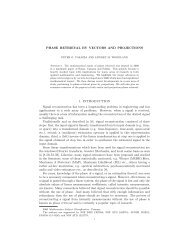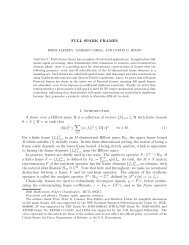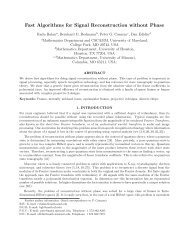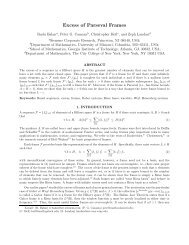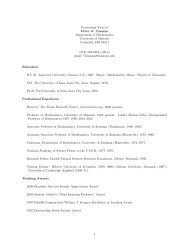Introduction to Finite Frame Theory - Frame Research Center
Introduction to Finite Frame Theory - Frame Research Center
Introduction to Finite Frame Theory - Frame Research Center
You also want an ePaper? Increase the reach of your titles
YUMPU automatically turns print PDFs into web optimized ePapers that Google loves.
<strong>Introduction</strong> <strong>to</strong> <strong>Finite</strong> <strong>Frame</strong> <strong>Theory</strong> 21<br />
(iii) For every x ∈ H N ,<br />
(iv) For every x ∈ H N ,<br />
(v) T / √ A is an isometry.<br />
x = A −1 ·<br />
A‖x‖ 2 =<br />
M<br />
∑<br />
i=1<br />
M<br />
∑<br />
i=1<br />
〈x,ϕ i 〉ϕ i .<br />
|〈x,ϕ i 〉| 2 .<br />
Proof. (i) ⇔ (ii) ⇔ (iii) ⇔ (iv). These are immediate from the definition of the<br />
frame opera<strong>to</strong>r and from Theorem 4.<br />
(ii) ⇔ (v). This follows from the fact that T / √ A is an isometry if and only if<br />
T ∗ T = A · Id. ⊓⊔<br />
A similar result for the special case of a Parseval frame can be easily deduced<br />
from Proposition 11 by setting A = 1.<br />
4.2.3 Eigenvalues of the <strong>Frame</strong> Opera<strong>to</strong>r<br />
Tight frames have the property that the eigenvalues of the associated frame opera<strong>to</strong>r<br />
all coincide. We next consider the general situation, i.e., frame opera<strong>to</strong>rs with<br />
arbitrary eigenvalues.<br />
The first and maybe even most important result shows that the largest and smallest<br />
eigenvalues of the frame opera<strong>to</strong>r are the optimal frame bounds of the frame.<br />
Optimality refers <strong>to</strong> the smallest upper frame bound and the largest lower frame<br />
bound.<br />
Theorem 5. Let (ϕ i ) M i=1 be a frame for H N with frame opera<strong>to</strong>r S having eigenvalues<br />
λ 1 ≥ ... ≥ λ N . Then λ 1 coincides with the optimal upper frame bound and λ N<br />
is the optimal lower frame bound.<br />
Proof. Let (e i ) N i=1<br />
denote the normalized eigenvec<strong>to</strong>rs of the frame opera<strong>to</strong>r S with<br />
respective eigenvalues (λ j ) N j=1 written in decreasing order. Let x ∈ H N be arbitrarily<br />
fixed. Since x = ∑ M j=1 〈x,e j〉e j , we obtain<br />
By Lemma 6, this implies<br />
M<br />
∑<br />
i=1<br />
Sx =<br />
|〈x,ϕ i 〉| 2 = 〈Sx,x〉 =<br />
=<br />
N<br />
∑<br />
j=1<br />
〈 N∑<br />
j=1<br />
λ j 〈x,e j 〉e j .<br />
λ j 〈x,e j 〉e j ,<br />
N<br />
∑<br />
j=1<br />
〈x,e j 〉e j<br />
〉<br />
N<br />
∑ j |〈x,e j 〉|<br />
j=1λ 2 N<br />
≤ λ 1 ∑ |〈x,e j 〉| 2 = λ 1 ‖x‖ 2 .<br />
j=1



